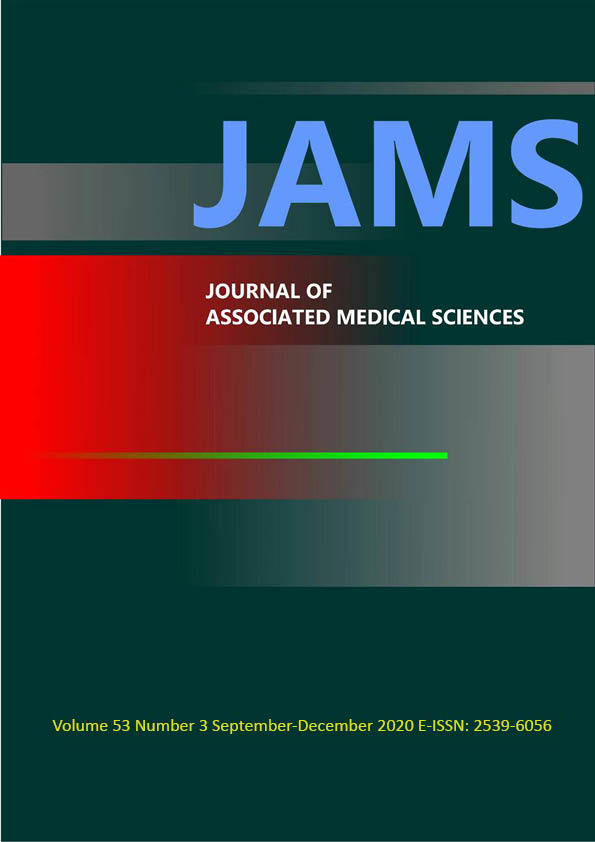In-house development of automatic iontophoresis current source for sweat chloride test
Main Article Content
Abstract
Background: The standard method for cystic fibrosis screening is pilocarpine iontophoresis sweat chloride test. The iontophoresis device must supply reliable and accurate electrical current within the safety range. The researchers determined that an in-house development of reliable automatic iontophoresis current source for sweat chloride test would have an impact to cost and popularity of the test in Thailand. Furthermore, it will promote the development of a technological self-reliance in the future.
Objectives: Automatic iontophoresis current source was designed and fabricated to conform to IEC 479-1 electrical safety standard and CLSI C34-A3 Sweat Chloride Testing Standard. Performance of the device was tested by performing sweat chloride test in healthy volunteers.
Materials and methods: Design and develop automatic iontophoresis current source for sweat chloride test with electrical safety standards IEC 479-1 and conform to CLSI C34-A3 standard. The developed device will be tested by performing classic sweat chloride test (CST) in healthy adult volunteers.
Results: Seventy healthy volunteers (age between 18 to 40 years old) were recruited. No history or signs of illness or being treated for diseases including the lungs, liver, pancreas, and intestines were found. 27 males and 43 females are compared between control and test with pilocarpine iontophoresis using stimulated direct current of 1.0 mA for 4 minute (0.07 mA/cm2) and 30 minutes for sweat collection. The electrical current used was far lower than recommendation by CLSI C34-A3 standard and other known studies, but still can give out weight of sweat (more than 0.077 gram) as recommended by CLSI C34-A3 standard. Mean weight of collected sweat in male volunteers are 0.35±0.10 gram and 0.17±0.08 gram in female volunteers. And there are significant differences in chloride concentration obtained from male and female volunteers that correlated with previous studies.
Conclusion: The in-house development of automatic iontophoresis current source device for sweat chloride test was successful and successfully used in the sweat chloride test in normal healthy adult volunteers. Sweat can be stimulated effectively with low iontophoresis current in normal subject. Moreover, compare with CLSI-C34-A3 recommendation, the device can stimulate sweat production far more than minimum sample weight of 0.077 gram with lower electric current and shorter duration of stimulated time.
Article Details

This work is licensed under a Creative Commons Attribution-NonCommercial-NoDerivatives 4.0 International License.
Personal views expressed by the contributors in their articles are not necessarily those of the Journal of Associated Medical Sciences, Faculty of Associated Medical Sciences, Chiang Mai University.
References
Knowles M, Gatzy J, Boucher R. Increased bioelectric potential difference across respiratory epithelia in cystic fibrosis. N Engl J Med 1981; 305(25): 1489-95.
Gaskin KJ, Durie PR, Corey M, Wei P, Forstner GG. Evidence for a primary defect of pancreatic HCO3- secretion in cystic fibrosis. Pediatr Res 1982; 16(7): 554-7.
Di Sant'Agnese PA, Darling RC, Perera GA, Shea E. Abnormal electrolyte composition of sweat in cystic fibrosis of the pancreas: clinical significance and relationship to the disease. Pediatrics 1953; 12(5): 549-63.
Gibson LE, Cooke RE. A test for concentration of electrolytes in sweat in cystic fibrosis of the pancreas utilizing pilocarpine by iontophoresis. Pediatrics 1959; 23(3): 545-9.
Clinical Laboratory Standards Institute formerly National Committee for Clinical Laboratory Standards. Sweat Testing: Sample Collection and Quantitative Analysis: Approved Guideline. NCCLS Document C34-A3. Wayne, PA, National Committee for Clinical Laboratory Standards, 2009.
Mo-Suwan L, Chungpanich S. Cystic fibrosis: a case report. J Med Assoc Thai 1981; 64(12): 630-5.
Pacharee P. Fibrocystic disease of the pancreas: a case report. J Med Assoc Thai 1975; 58(2): 110-2.
Suwanjutha S, Huang NN, Wattanasirichaigoon D, Sura T, Harris A, Macek M. Case Report of a Thai Male Cystic Fibrosis Patient With the 1898+ 1G--> T Splicing Mutation in the CFTR Gene: A Review of East Asian Cases. Hum Mutat 1998; 12: 361.
Teeratakulpisarn J, Kosuwon P, Srinakarin J, Panthongviriyakul C, Sutra S. Cystic fibrosis in three northeast Thai infants is CF really a rare disease in the Thai population?. J Med Assoc Thai 2006; 89(10): 1756-61.
Schwarz V, Sutcliffe CH, Style PP. Some hazards of the sweat test. Arch Dis Child 1968; 43(232): 695.
Versatile High Precision Programmable Current Sources Using DACs OpAmps, and MOSFET Transistors. [Internet]. 2011 [cited 2019 Apr 30]. Available from: www.analog.com/media/en/reference-design-documentation/reference-designs/CN0151.pdf
Microchip Technology Inc. MCP4921/4922 12 Bit DAC with SPITM Interface datasheet; 2007. [Internet].
[cited 2019 Apr 30]. Available from: http://ww1.microchip.com/downloads/en/devicedoc/21897b.pdf.
KylinChip Electronic (Shanghai) Co., Ltd. 400KHz 60V4A Switching Current Boost/ Buck-Boost/Inverting DC/DC Converter. [Internet]. [cited 2019 Apr 30]. Available from: http://www.haoyuelectronics.com/Attachment/XL6009/XL6009-DC-DC-Converter-Datasheet.pdf.
Lawler JC, Davis MJ, Griffith EC. Electrical characteristics of the skin: The impedance of the surface sheath and deep tissues. J Invest Dermatol 1960 May; 34: 301-8.
Mattar AC, Gomes EN, Adde FV, Leone C, Rodrigues JC. Comparison between classic Gibson and Cooke technique and sweat conductivity test in patients with and without cystic fibrosis. J Pediatr (Rio J) 2010; 86(2): 109-14.
Gomez CC, Servidoni Mde F, Marson FA, Canavezi PJ, Vinagre AM, Costa ET, et al. Pulsed direct and constant direct currents in the pilocarpine iontophoresis sweat chloride test. BMC Pulm Med 2014; 14: 198.
Gibson TE, Shelley WB. Sexual and racial differences in the response of sweat glands to acetylcholine and pilocarpine. J Invest Dermatol 1948; 11(2): 137-42.
Ohara K. Chloride concentration in sweat; its individual, regional, seasonal and some other variations, and interrelations between them. The Japanese journal of physiology 1966; 16(3): 274-90.
Morimoto T, Slabochova Z, Naman R, Sargent 2nd F. Sex differences in physiological reactions to thermal stress. J Appl Physiol 1967; 22(3): 526-32.
Main K, Nilsson KO, Skakkebaek NE. Influence of sex and growth hormone deficiency on sweating. Scand J Clin Lab Invest 1991; 51(5): 475-80.


